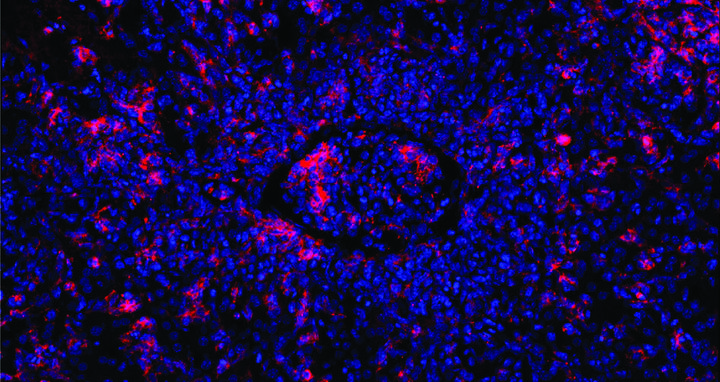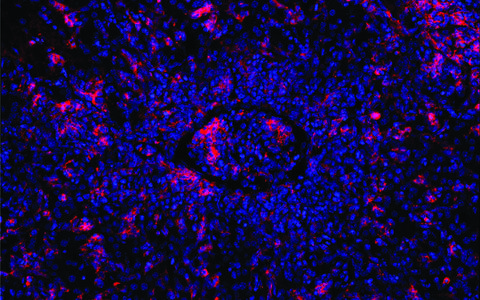Gene editing precisely repairs immune cells
Familial hemophagocytic lymphohistiocytosis (FHL) is a rare disease of the immune system that usually occurs in infants and young children under the age of 18 months. The condition is severe and has a high mortality rate. It is caused by various gene mutations that prevent cytotoxic T cells from functioning normally. These are a group of immune cells that kill virus-infected cells or otherwise altered cells. If a child with FHL contracts a virus – such as the Epstein-Barr virus (EBV), but also other viruses – the cytotoxic T cells cannot eliminate the infected cells. Instead, the immune response gets out of control. This leads to a cytokine storm and an excessive inflammatory reaction that affects the entire organism.
“Doctors treat FHL with a combination of chemotherapy, immunosuppression and bone marrow transplantation, but many children still die of the disease,” says Professor Klaus Rajewsky, who heads the Immune Regulation and Cancer Lab at the Max Delbrück Center. He and his team have therefore developed a new therapeutic strategy. Using the CRISPR-Cas9 gene-editing tool, the researchers succeeded in repairing defective T cells from mice and from two critically ill infants. The repaired cytotoxic T cells then functioned normally, with the mice recovering from hemophagocytic lymphohistiocytosis. Rajewsky and his team have now published their findings in “Science Immunology.” The journal features the paper as its cover story.
Gene repair strategy works in mice
The starting point for the study were mice in which the team could mimic EBV infections. In these animals, the researchers altered a gene called perforin so that its function was completely lost or severely compromised – a common genetic defect in patients with FHL. When they then elicited a condition resembling an EBV infection, the affected B cells multiplied uncontrollably because the defective cytotoxic T cells were unable to eliminate them. As a result, the immune response went into overdrive and the mice developed hemophagocytic lymphohistiocytosis.
Liver tissue from a mouse model of a rare immune disease called FHL: Mutated T cells are unable to kill B cells (red) induced by the Epstein-Barr virus. This causes other immune cells to flow into the area of infection, thereby blocking a blood vessel (center).
The team next collected T memory stem cells – that is, long-lived T cells from which active cytotoxic T cells can mature – from the blood of the mice. The researchers used the CRISPR-Cas9 gene-editing tool to repair the defective perforin gene in the memory T cells and then injected the corrected cells back into the mice. The immune response in the animals quieted down and their symptoms disappeared.
How long protection lasts is uncertain
We very much hope that our mechanism of action is a leap forward in treating FHL. Either to gain more time for a successful bone marrow transplant or even as a treatment itself.
The first author of the paper, Dr Xun Li, used blood samples from two sick infants to test whether the strategy also works in humans. One had a defective perforin gene, the other a different defective gene. “Our gene repair technique is more precise than previous methods, and the T cells are virtually unchanged after undergoing gene editing,” says Li. “It was also fascinating to see how effectively the memory T cells could be multiplied and repaired from even a small amount of blood.” Cell culture experiments showed that the infants’ repaired T memory cells were capable of a normal cytotoxic T cell response.
This means the therapeutic mechanism works in principle. But before patients can benefit from this discovery, the team needs to first resolve open questions and test the treatment concept in clinical trials. “It is still uncertain how long the protective effect lasts,” says Dr Christine Kocks, a scientist in Rajewsky’s team. “Since the T memory stem cells remain in the body for a long time, we hope the therapy provides long-term or even permanent protection. It is also conceivable that patients could be treated with their repaired T cells over and over again.”
The procedure is minimally invasive since only a small amount of blood is needed, and the mice did not require any preparatory treatment – unlike, for example, with a bone marrow transplant. “We very much hope that our mechanism of action is a leap forward in treating FHL,” says Rajewsky, “either to gain more time for a successful bone marrow transplant or even as a treatment itself.”
Text: Stefanie Reinberger
Further information
Literature
Xun Li et al (2024): „Precise CRISPR-Cas9 gene repair in autologous memory T cells to treat familial hemophagocytic lymphohistiocytosis“. Science Immunology, DOI: 10.1126/sciimmunol.adi0042
Download
Liver tissue from a mouse model of a rare immune disease called FHL: Mutated T cells are unable to kill B cells (red) induced by the Epstein-Barr virus. This causes other immune cells to flow into the area of infection, thereby blocking a blood vessel (center). Photo: Elijah D. Lowenstein und Xun Li, AG K. Rajewsky, Max Delbrück Center
Contacts
Prof. Klaus Rajewsky
Head of the Immune Regulation and Cancer Lab
Max Delbrück Center
+49 30 9406 2391 (Büro)
Klaus.Rajewsky@mdc-berlin.de
Dr Christine Kocks
Scientist in the Immune Regulation and Cancer Lab
Max Delbrück Center
+49 30 9406-2395
Christine.Kocks@mdc-berlin.de
Jana Schlütter
Editor, Communications
Max Delbrück Center
+49 30 9406-2121
jana.schluetter@mdc-berlin.de or presse@mdc-berlin.de
- Max Delbrück Center
The Max Delbrück Center for Molecular Medicine in the Helmholtz Association (Max Delbrück Center) is one of the world’s leading biomedical research institutions. Max Delbrück, a Berlin native, was a Nobel laureate and one of the founders of molecular biology. At the locations in Berlin-Buch and Mitte, researchers from some 70 countries study human biology – investigating the foundations of life from its most elementary building blocks to systems-wide mechanisms. By understanding what regulates or disrupts the dynamic equilibrium of a cell, an organ, or the entire body, we can prevent diseases, diagnose them earlier, and stop their progression with tailored therapies. Patients should be able to benefit as soon as possible from basic research discoveries. This is why the Max Delbrück Center supports spin-off creation and participates in collaborative networks. It works in close partnership with Charité – Universitätsmedizin Berlin in the jointly-run Experimental and Clinical Research Center (ECRC), the Berlin Institute of Health (BIH) at Charité, and the German Center for Cardiovascular Research (DZHK). Founded in 1992, the Max Delbrück Center today employs 1,800 people and is 90 percent funded by the German federal government and 10 percent by the State of Berlin.







